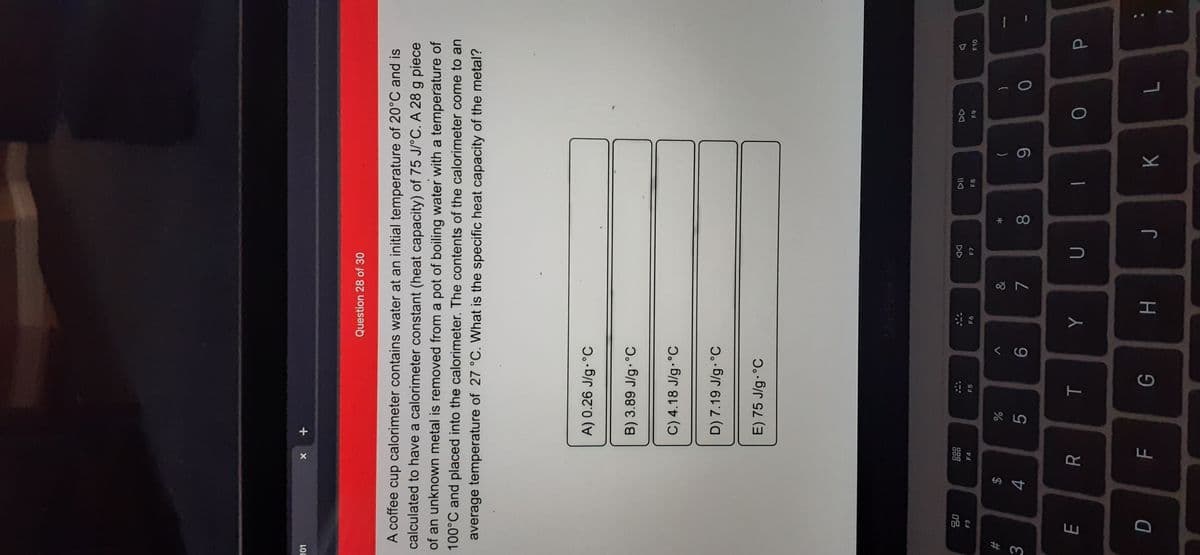A coffee cup calorimeter contains water at an initial temperature of 20°C and is calculated to have a calorimeter constant (heat capacity) of 75 J/°C. A 28 g piece of an unknown metal is removed from a pot of boiling water with a temperature of 100°C and placed into the calorimeter. The contents of the calorimeter come to an average temperature of 27 °C. What is the specific heat capacity of the metal? A) 0.26 J/g C B) 3.89 J/g °C C) 4.18 J/g-°C D) 7.19 J/g-°C E) 75 J/g-°C
A coffee cup calorimeter contains water at an initial temperature of 20°C and is calculated to have a calorimeter constant (heat capacity) of 75 J/°C. A 28 g piece of an unknown metal is removed from a pot of boiling water with a temperature of 100°C and placed into the calorimeter. The contents of the calorimeter come to an average temperature of 27 °C. What is the specific heat capacity of the metal? A) 0.26 J/g C B) 3.89 J/g °C C) 4.18 J/g-°C D) 7.19 J/g-°C E) 75 J/g-°C
Chemistry & Chemical Reactivity
9th Edition
ISBN:9781133949640
Author:John C. Kotz, Paul M. Treichel, John Townsend, David Treichel
Publisher:John C. Kotz, Paul M. Treichel, John Townsend, David Treichel
Chapter5: Principles Of Chemical Reactivity: Energy And Chemical Reactions
Section: Chapter Questions
Problem 39PS: A piece of titanium metal with a mass of 20.8 g is heated in boiling water to 99.5 C and then...
Related questions
Question
100%

Transcribed Image Text:*
T
FL
LU
LOL
+ x
Question 28 of 30
A coffee cup calorimeter contains water at an initial temperature of 20°C and is
calculated to have a calorimeter constant (heat capacity) of 75 J/°C. A 28 g piece
of an unknown metal is removed from a pot of boiling water with a temperature of
100°C and placed into the calorimeter. The contents of the calorimeter come to an
average temperature of 27 °C. What is the specific heat capacity of the metal?
A) 0.26 J/g.°C
B) 3.89 J/g.°C
C) 4.18 J/g.°C
D) 7.19 J/g.°C
E) 75 J/g. °C
000
000
F3
DD
F4
F5
F7
93
F10
65
&
#3
2$
3.
8.
6.
K
Expert Solution
This question has been solved!
Explore an expertly crafted, step-by-step solution for a thorough understanding of key concepts.
This is a popular solution!
Trending now
This is a popular solution!
Step by step
Solved in 3 steps

Knowledge Booster
Learn more about
Need a deep-dive on the concept behind this application? Look no further. Learn more about this topic, chemistry and related others by exploring similar questions and additional content below.Recommended textbooks for you

Chemistry & Chemical Reactivity
Chemistry
ISBN:
9781133949640
Author:
John C. Kotz, Paul M. Treichel, John Townsend, David Treichel
Publisher:
Cengage Learning

Chemistry & Chemical Reactivity
Chemistry
ISBN:
9781337399074
Author:
John C. Kotz, Paul M. Treichel, John Townsend, David Treichel
Publisher:
Cengage Learning

Chemistry: Principles and Reactions
Chemistry
ISBN:
9781305079373
Author:
William L. Masterton, Cecile N. Hurley
Publisher:
Cengage Learning

Chemistry & Chemical Reactivity
Chemistry
ISBN:
9781133949640
Author:
John C. Kotz, Paul M. Treichel, John Townsend, David Treichel
Publisher:
Cengage Learning

Chemistry & Chemical Reactivity
Chemistry
ISBN:
9781337399074
Author:
John C. Kotz, Paul M. Treichel, John Townsend, David Treichel
Publisher:
Cengage Learning

Chemistry: Principles and Reactions
Chemistry
ISBN:
9781305079373
Author:
William L. Masterton, Cecile N. Hurley
Publisher:
Cengage Learning

Chemistry for Engineering Students
Chemistry
ISBN:
9781337398909
Author:
Lawrence S. Brown, Tom Holme
Publisher:
Cengage Learning

Chemistry
Chemistry
ISBN:
9781305957404
Author:
Steven S. Zumdahl, Susan A. Zumdahl, Donald J. DeCoste
Publisher:
Cengage Learning
